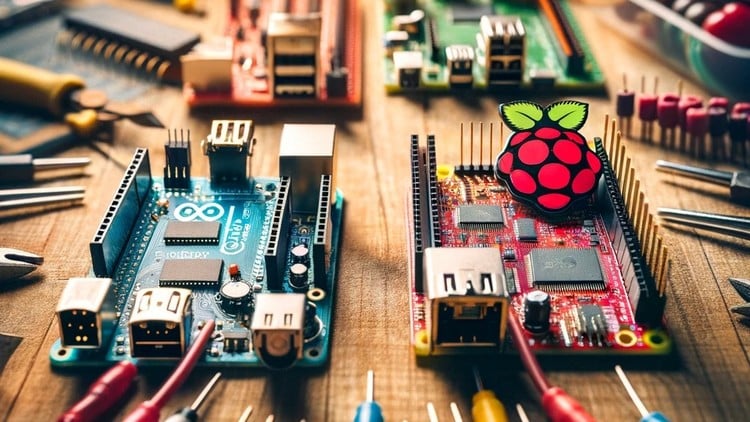
You will no longer wonder what board should you start with, or what board should you learn or use.
⏱️ Length: 1.4 total hours
⭐ 4.00/5 rating
👥 15,027 students
🔄 June 2025 update
Add-On Information:
Note➛ Make sure your 𝐔𝐝𝐞𝐦𝐲 cart has only this course you're going to enroll it now, Remove all other courses from the 𝐔𝐝𝐞𝐦𝐲 cart before Enrolling!
- Course Caption:
- You will no longer wonder what board should you start with, or what board should you learn or use. Length: 1.4 total hours 4.00/5 rating 15,027 students June 2025 update
- What You Will Learn:
- Choose the right board that fulfills your needs
- Differentiate between each of the boards and why one is better than the other
- Course Overview:
- This concise course directly compares three foundational embedded platforms: Arduino, Raspberry Pi, and PIC Microcontrollers.
- It highlights each platform’s unique strengths and optimal applications, guiding your hardware decisions for any project.
- Understand core architectural differences, operational philosophies, and ecosystem specificities of these powerful hardware options.
- Discover essential selection considerations: processing power, memory, power consumption, development complexity, cost-effectiveness, and community support.
- Transform your hardware approach by strategically matching project requirements with the most suitable microcontroller or single-board computer.
- Requirements / Prerequisites:
- Basic computer literacy and internet access are the only technical prerequisites.
- No prior experience in electronics, programming, or embedded systems is required, making it ideal for beginners.
- A keen interest in understanding hardware capabilities and developing embedded projects.
- Skills Covered / Tools Used:
- Comparative System Analysis: Master evaluating diverse hardware platforms based on technical and functional criteria.
- Strategic Platform Selection: Develop the ability to choose the most appropriate embedded solution (MCU/SBC) for specific project constraints.
- Architectural Differentiation: Gain insights into fundamental hardware architectures distinguishing microcontrollers from single-board computers.
- Ecosystem Navigation: Understand typical development environments, programming paradigms, and peripheral interfaces for each platform.
- Resource Optimization: Learn to weigh factors like processing power, memory, power budget, and connectivity against project needs.
- Cost-Benefit Evaluation: Acquire the skill to assess total cost of ownership, including hardware, tools, and learning curve.
- Scalability and Future-Proofing: Explore how platform choice impacts long-term viability and expansion potential of your embedded projects.
- Application-Specific Matching: Pinpoint which platform excels in real-time control, IoT, data processing, or human-machine interface design.
- Benefits / Outcomes:
- Unwavering Project Confidence: Eliminate guesswork and make hardware choices with clear understanding.
- Streamlined Development Workflow: Accelerate project timelines by selecting the optimal platform early, reducing trial and error.
- Economical Resource Management: Optimize budget and power consumption by precisely matching your board to project demands.
- Holistic Embedded Systems Perspective: Develop a comprehensive view of the embedded landscape and hardware interplay.
- Enhanced Problem-Solving Acumen: Approach technical challenges with a broadened toolkit, identifying best-suited platforms.
- Empowered Innovation: Unleash creative potential through hardware decisions enabling unique project functionalities.
- Solid Foundational Knowledge: Build a robust base for further specialization in covered platforms or advanced embedded topics.
- Improved Career Readiness: Equip yourself with versatile knowledge valued in embedded system design, prototyping, and optimization.
- PROS:
- Offers a highly focused, direct comparison of major embedded platforms.
- Extremely time-efficient, delivering critical insights in a compact 1.4-hour format.
- Addresses a pervasive confusion for beginners and intermediate enthusiasts.
- Backed by strong student satisfaction (4.00/5) with effective, valuable content.
- Empowers learners with actionable knowledge for immediate project application.
- Regularly updated (June 2025) ensures relevance with current hardware trends.
- Breaks down complex technical differences into digestible comparisons.
- Facilitates a strategic, less trial-and-error approach to development.
- Ideal for quick, decisive guidance on hardware selection.
- CONS:
- Due to its concise, comparative nature, it does not delve deeply into programming or specific project implementations.
Learning Tracks: English,IT & Software,Other IT & Software
Found It Free? Share It Fast!